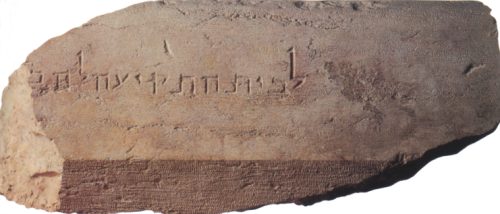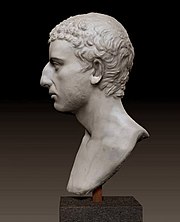Round One: Primary Evidence of the Destruction of the Temple.
Primary source is a term used in a number of disciplines to describe source material that is closest to the person, information, period, or idea being studied. The primary evidence for the destruction of the temple in Jerusalem consists of
- Remains of the Temple itself
- Jewish coins (attesting to the existence of the rebellion)
- Roman coins
- Josephus' Wars of the Jews
- the Talmud (Gittin 57b)
Historical Context: the destruction of the Temple occurred as part of the first Jewish-Roman War (66–73). That war ended when legions under Titus besieged and destroyed the center of rebel resistance in Jerusalem, and defeated the remaining Jewish strongholds.

A stone from the Temple with a Greek language inscription warning gentiles to refrain from entering the Temple enclosure, on pain of death.

A stone (2.43x1 meters) with Hebrew language inscription "To the Trumpeting Place" excavated by B. Mazar at the southern foot of the Temple Mount. It is believed that this was a part of the Second Temple.

Today's Western Wall formed part of the retaining perimeter wall of the platform for a massive expansion project on the Temple Mount by Herod the Great.

The Little Western Wall, (Hebrew: הכותל הקטן‎, HaKotel HaKatan), is a Jewish religious site located in the Muslim Quarter of the Old City of Jerusalem near the Iron Gate to the Temple Mount. The wall itself dates from the Second Temple period, (516 BCE - 70 CE).
Titus, the future emperor, led the Roman troops against the Jewish rebels. We know what he looked like.

Here is a marble bust made ca. 79CE.

Here is the image of Titus on a coin from June-July 79 CE. on the reverse is a Jewish captive kneeling right in front of trophy of arms.
On September 25, 2007 Yuval Baruch, archaeologist with the Israeli Antiquities Authority announced the discovery of a quarry compound which may have provided King Herod with the stones to build his Temple on the Temple Mount. Coins, pottery and an iron stake found proved the date of the quarrying to be about 19 B.C. Archaeologist Ehud Netzer confirmed that the large outlines of the stone cuts is evidence that it was a massive public project worked by hundreds of slaves.
The sources of knowledge that we have of this war are: Josephus's account, the Talmud (Gittin 57b), Midrash Eichah, and the Hebrew inscriptions on the Jewish coins minted.
The Wars of the Jews (or The History of the Destruction of Jerusalem, or as it usually appears in modern English translations, The Jewish War - original title: Φλαυίου Ἰωσήπου ἱστοÏ�ία Ἰουδαϊκοῦ πολÎμου Ï€Ï�ὸς Ῥωμαίους βιβλία) is a book written by the 1st century Jewish historian Josephus.

Josephus.
It is a description of Jewish history from the capture of Jerusalem by the Seleucid ruler Antiochus IV Epiphanes in 164 BC to the fall and destruction of Jerusalem in the First Jewish-Roman War in AD 70. The book was written about 75, originally in Josephus's "paternal tongue", probably Aramaic, though this version has not survived. It was later translated into Greek, probably under the supervision of Josephus himself.
In 69, Josephus was released by the Romans, having been a prisoner of war. He then played a role as a negotiator with the defenders during the Siege of Jerusalem in 70.
If a number of
independent sources contain the same message, the credibility of the message is strongly increased. For this event, we have the Romans, a Jewish historian working for the Romans, and the Jews.
All of the statements made by these sources seem inherently probable, that is that they are consistent with human nature, and with what we know about the history of the area and the nature of human conflict.
In our agreed upon method, it is stated:
C. Behan McCullagh lays down seven conditions for a successful argument to the best explanation:
- The statement, together with other statements already held to be true, must imply yet other statements describing present, observable data. (We will henceforth call the first statement 'the hypothesis', and the statements describing observable data, 'observation statements'.)
- The hypothesis must be of greater explanatory scope than any other incompatible hypothesis about the same subject; that is, it must imply a greater variety of observation statements.
- The hypothesis must be of greater explanatory power than any other incompatible hypothesis about the same subject; that is, it must make the observation statements it implies more probable than any other.
- The hypothesis must be more plausible than any other incompatible hypothesis about the same subject; that is, it must be implied to some degree by a greater variety of accepted truths than any other, and be implied more strongly than any other; and its probable negation must be implied by fewer beliefs, and implied less strongly than any other.
- The hypothesis must be less ad hoc than any other incompatible hypothesis about the same subject; that is, it must include fewer new suppositions about the past which are not already implied to some extent by existing beliefs.
- It must be disconfirmed by fewer accepted beliefs than any other incompatible hypothesis about the same subject; that is, when conjoined with accepted truths it must imply fewer observation statements and other statements which are believed to be false.
- It must exceed other incompatible hypotheses about the same subject by so much, in characteristics 2 to 6, that there is little chance of an incompatible hypothesis, after further investigation, soon exceeding it in these respects.
I am having some difficulty applying this reasoning to the destruction of the Temple, since, try as I might, I cannot find any historian offering up any hypothesis other than the one that I am proposing. But let me give it a try.
Let us propose as an alternative hypothesis to the Temple being destroyed by the Romans in the war, that God himself saved the Temple from destruction and raised it into heaven.
- This hypothesis is consistent with the observable data.
- However, this hypothesis does not have greater explanatory scope than the war one.
- Nor does it have greater explanatory power than the war hypothesis.
- It certainly has less plausibility than the war hypothesis.
- The direct divine intervention hypothesis is more ad hoc than the war hypothesis.
- It is not disconfirmed by fewer accepted beliefs.
- It certainly does not outdo [1]-[6]
McCullagh [no relation BTW] sums up, "if the scope and strength of an explanation are very great, so that it explains a large number and variety of facts, many more than any competing explanation, then it is likely to be true."
The war hypothesis, based on the primary evidence, explains a large number and variety of facts, so many more than any competing explanation that there are virtually no competing explanations.









